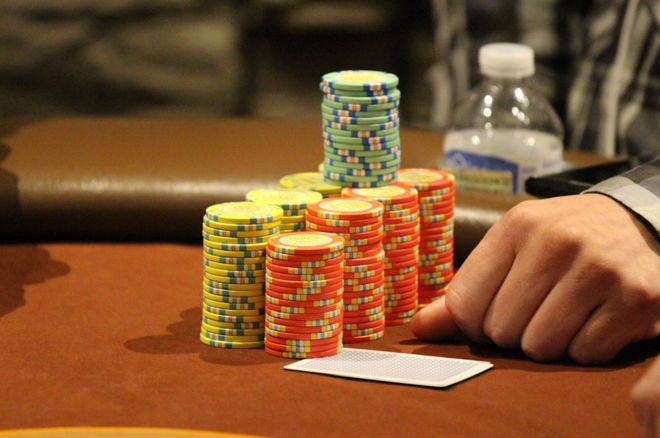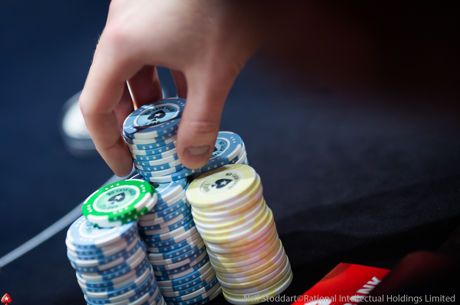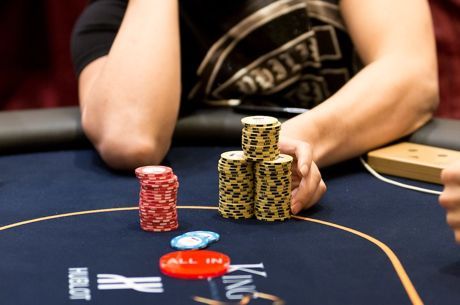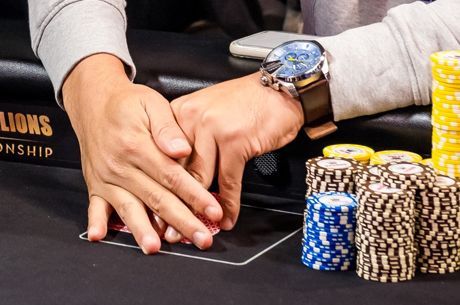Aggression After the Flop: The 'Semi-Demi-Bluff'

I introduced a concept in limit poker about 15 years ago that I still rely on today in no-limit from time to time. I present it here for you to review and consider. I've found it useful in tipping the scales toward aggression, when standard methods of bluffing and semi-bluffing may not be sufficient to warrant it.
We all know that a bluff is an attempt to make our hand appear more powerful than it actually is with the intent of deceiving our opponents into folding or otherwise misplaying their stronger hands. Betting a missed flush draw as if it were a flush is an example of a bluff (often a mistake, by the way, but an example of a bluff nevertheless).
A semi-bluff is a variation on the theme, incorporating the possibility that our hand may improve to a strong hand on the next card. Having A?K? and betting with a board of Q?10?8?7? is an example of that. Our large bet on the turn might win us the pot as a bluff, if our opponent believes we hit our straight or flush. Or we might win by improvement on the river if a heart or a jack hits.
Adding the chances that we might win by improvement to the chances that we might win as a bluff can sometimes make a semi-bluff a worthwhile form of aggression, even when a naked bluff would be an error.
And sometimes�� sometimes we have a third factor that we should consider when making a bet or raise that is, at the moment, primarily a bluff. Each factor, separately, might not warrant a bet or raise. But when added together, they may warrant it.
For instance, suppose you have an opponent who has been the aggressor preflop and on the flop. He then bets the turn. You might be able to convince him to fold his hand with a raise, but you estimate the odds of that ploy succeeding to be very modest, making the bluff itself unprofitable.
But you have a draw that might come on the river. That possibility that you might improve on the next card adds some more value to your bluffing attempt. But even when you add those two possibilities together, you realize that it's not sufficient to warrant a bet. It would still be a negative EV move.
Typically, at this point you discount aggression and decide either to call with your draw (if you think you have the pot odds or implied odds to justify it) or to fold. However, there is one final consideration that might move you to raise after all.
Sometimes, in this spot, you have a hand that might be ahead of some hands in your opponent's range. You're still drawing to a very strong hand, but your hand already has some (perhaps modest) value. Accordingly, you may have some cause to raise as a value bet.
The value of your hand alone, when considered solely against the likely range of your opponent, would not justify the raise. But when you add up the possibilities that (1) your bet might get your opponent to fold, (2) your bet might get called but you could still improve to a winner on the river, and (3) your hand actually might be good right now, you have a good case for raising.
Here's another, more concrete example of the situation I'm describing. It's from a $1/$2 game.
You have 9?9? on the button, and a very aggressive player in middle position open-raises to $10. Two loose players call, and you call as well. There is $43 in the pot.
The flop comes 10?8?5?, and the preflop raiser continues for $25. The two callers now fold. You call, thinking it very possible that, in addition to hands like Q-Q+, A-T, K-T, Q-T, and J-T that he is representing, your opponent is also quite possibly c-betting with a wider range that includes naked overcards like A-K, A-Q, A-J, K-Q, K-J, Q-J, cards that bottom- or middle-paired like A-8 and A-5, and low and middle pairs like 2-2, 3-3, 4-4, 6-6, and 7-7. You doubt he'd play a really strong hand for a bet at this point, so you discount 5-5 and 8-8.
There's $93 in the pot when the turn brings the J?. At this point in the action you have an effective stack of $200. Your opponent bets $50.
Since you've seen him frequently fire a second barrel, you put him on the same very wide range that he had on the flop. The jack on the turn has surely improved his hand some of the time, making him a pair higher than your nines. On the other hand there are still many hands in his range with which he's missed. But he's likely to keep firing, anyway.
You also realize that you have a fairly tight image. A raise from you here, representing a set or a straight, might be sufficient to get him to fold. There's the possibility that he might well call you, though, knowing you can be tricky and would not be above a semi-bluff in this spot with only a draw.
After thinking about your chances of success, you estimate a 25 percent chance of winning the pot as a bluff by shoving for another $150 on top of his bet. You don't think a smaller amount will even be that effective.
Therefore, as just a bluff, the move does not have a positive EV.
You add in your chances of improvement on the river. Your open-ended straight draw gives you eight outs, plus you have two more outs to make a set (which may or may not be good). That gives you more equity �� say at least 16 percent, possibly a bit more. Even with that, the semi-bluff won't show a profit. You can't even count any implied odds, since you'd be all in with no more money to be made if you hit.
But then you realize that your 9?9? itself might be good. When you think about his calling range you realize that pocket nines is right in the middle of it �� in other words, better than many of his calling hands. Your opponent could be calling you with just overcards or a lower pair, hoping to improve on the river. That is to say, you might not need to improve yourself to win when your opponent calls �� he may be behind.
When you add that into the equation and realize that you may actually be making a very thin value raise against his likely broad betting range here, the raise may make sense. There's not enough there just to be bluffing or semi-bluffing, but the added possibility that you might have the better hand might justify the raise.
I gave this play a name, perhaps a silly one. I call it a "semi-demi-bluff" �� that is, a semi-bluff that also may have some value at showdown if there's no more betting.
I've found that this added bit of value can sometimes justify aggression even when a semi-bluff does not have a sufficient chance of winning. In any event, it's worth considering when contemplating whether or not to take an aggressive line in spots such as these.
Ashley Adams has been playing poker for 50 years and writing about it since 2000. He is the author of hundreds of articles and two books, Winning 7-Card Stud (Kensington 2003) and Winning No-Limit Hold'em (Lighthouse 2012). He is also the host of poker radio show House of Cards. See www.houseofcardsradio.com for broadcast times, stations, and podcasts.









